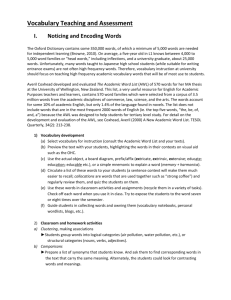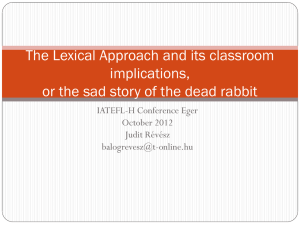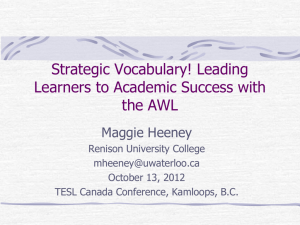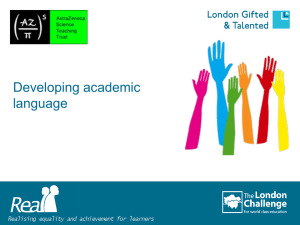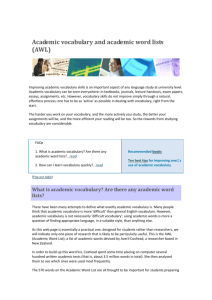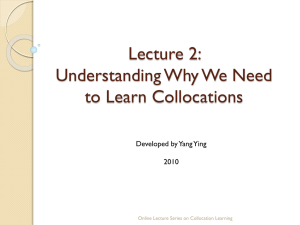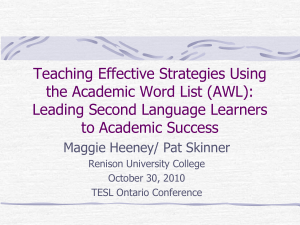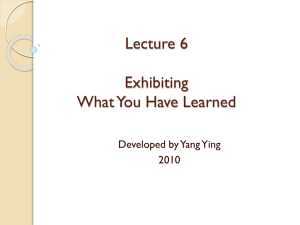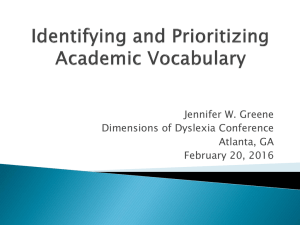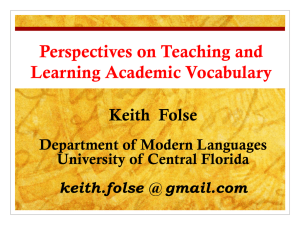Nagy and Townsend, 2012:91
advertisement
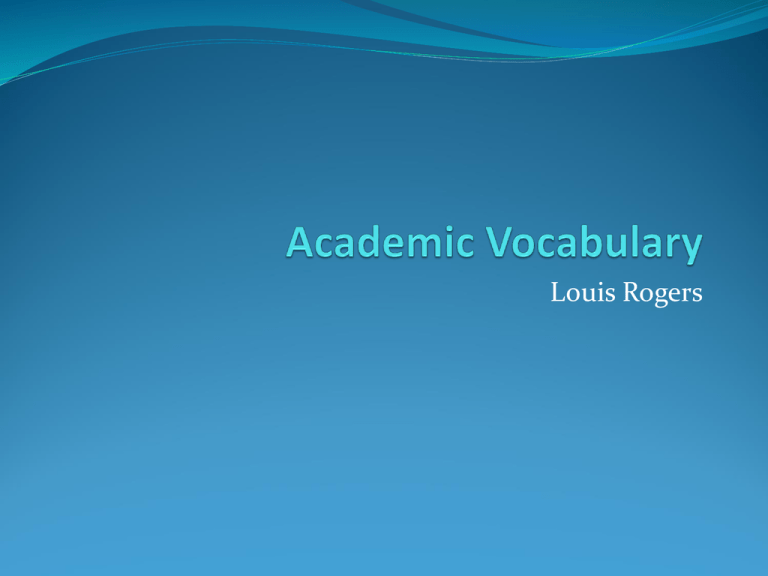
Louis Rogers www.macmillanskillful.com/ Overview Defining academic vocabulary The Academic Word List The Academic Keyword List Beyond individual words Vocabulary and reading Academic vocabulary There is no exact boundary when defining academic language; it falls toward one end of a continuum (defined by formality of tone, complexity of content, and degree of impersonality of stance), with informal, casual, conversational language at the other extreme. (Snow, 2010:450) Academic language is the specialized language, both oral and written, of academic settings that facilitates communication and thinking about disciplinary content. (Nagy and Townsend, 2012:91) Academic vocabulary Latin and Greek vocabulary eat/dine, right/correct abstract, analyze, aspect Morphologically complex words Predisposition Nouns, adjectives and prepositions 4:1 Vs. 1:1 (Nagy and Townsend, 2012) Academic vocabulary Grammatical metaphor, including nominalization Informational density ratio of content words to total words Abstractness respiration Just because people who read more can read better doesn’t mean that if you read more this will make you read better. The correlation between amount of reading and reading ability does not imply a causal relationship (Nagy and Townsend, 2012) The Academic Word List Academic Word List The Academic Word List (Coxhead) 4 discipline areas 3.5 million word corpus 570 word families West’s 1953 General Service List General Academic Vocabulary 75% = 2000 most frequent words 10-15% = academic vocabulary 10-15% = specialist vocabulary Academic Word List Job Examine Quantitative Qualitative Omission Persuasion Classification Determine Criticisms Multi-meaning words Volume Attribute Is one core list possible? Moving beyond individual words General Service List + AWL Address, control, means Address-issue, control-group, by-means Too general? www.lextutor.ca 2000 + 570 = 85% 10% AWL 75% 2000 The Academic Word List Used in numerous books Key to developing the area: Coxhead and Hirsh (2007) Science word list Wang, Liang and Ge (2008) Medical academic word list Ward (2009) Engineering word list Brought lexis and further research to the fore Academic Keyword List Collection and purpose Magali Paquot (2010) Does not exclude high frequency words 930 word list Includes published academic texts and two student corpora Collection and purpose 50% from first 1000 words 97% from first 2000 + AWL 37.5% from AWL AWL + 2000 = 85% text Aimed more at writing than reading Criticisms Transferability Vs. Specificity still in question Arguably both needed at different stages High frequency necessary Single item focus Beyond individual words Collocations Hyland 2008 Electronic Engineering Biology Business Studies Applied linguistics 4 word bundles 50 most frequent On the other hand, as well as the, in the case of, at the same time, the results of the Half on one list only Collocations Function of collocations Research-orientated = location, procedure, quantification, description, topic At the same time, the purpose of, a wide range of, the size of the, the currency board system Text-orientated = transition, results, structure, framing In addition to the, it was found that, in the next section, with the exception of Collocations Participant-orientated = stance, engagement It is possible that, as can be seen Discipline Researchorientated Textorientated Participantorientated Biology 48.1% 43.5% 8.4% Electrical engineering 49.4% 40.4% 9.2% Applied linguistics 31.2% 49.5% 18.6% Business studies 36% 48.4% 16.6% Collocation Hyland and Tse (2007) marketing strategy learning strategy coping strategy Durrant (2009) Life Sciences, Science and Engineering, SocialPsychological, Social-administrative, Arts and Humanities 1000 two-word collocations across all 5 areas Collocation Three quarters grammatical Reporting pattern ‘verb + that’ Argue, assume, conclude, confirm, demonstrate, emphasize, hypothesize, imply, indicate, note, predict, reveal, show, speculate, suggest, suppose Frequency and pattern combined Transferability of use not investigated Based on, associate with, note that, defined as, relationship between, effects on, indicate that Students Vs. Published Materials Learner English Vs. native speaker academic English 50% of AKL underused Basis, extent, assume, appropriate 21.4% overused Aim, fact, main, also, often Amplify high frequency and diminish low ones idea/problem Vs. hypothesis/conversely Many high frequency words under used Argument, significant, particularly Between, in, by of = avoidance of noun modification (Paquot, 2010) Learner English Vs. native speaker academic English Lack of register awareness Clusters or sequences For example, more and more, the problem is that In particular, in terms of, a considerable degree Semantic misuse On the contrary Chains of connective devices (Paquot, 2010) Vocabulary and Reading Skills and strategies Do they exist? Are they needed? skimming, scanning, predicting Used by weak learners to cope Used by good learners to enrich meaning Critical thinking perhaps only possible if text processing is automatized Impact of accessibility Poor word recognition > poor comprehension > practice is avoided Cunningham and Stanovich (1998) Skills develop and word recognition improve Vocabulary Background knowledge Complex structures (Chall, 1983) Vocabulary growth Bulk of growth Indirect exposure Vs. direct teaching Reading Vs. Oral language Reading and Vocabulary Printed texts Rank of median word Abstracts of scientific articles 4389 Newspapers 1690 Popular magazines 1399 Adult books 1058 Comic books 867 Children’s books 627 Pre-school books 578 Reading and vocabulary (Stanovich and Cunningham, 1998) Reading and vocabulary Speech lexically impoverished Children’s books considerably rarer than most spoken forms Adult books twice as prolific as speech Rare words (outside 10,000) 128/1000 scientific abstracts 20-30/1000 in all forms of speech How many words do learners need? 3000 words (Laufer, 1992) 10,000 words (Hazenberg and Hulstijn, 1996) 1000 – 2000 (Laufer, 2000) AWL + 2000 – is it enough? 98% text coverage (Nation) Conclusion Select list carefully to match aims Pitch the level carefully Balance skills and language carefully www.macmillanskillful.com/ Bibliography Anthony, L. (2011). Products, processes and practitioners: A critical look at the importance of specificity in ESP. Taiwan International ESP Journal. Vol 3:2 1-8 Bennett, K. (2009). English academic style manuals: A survey. English for specific purposes. 8 p43-54. Biber, D, Conrad, S and Leech, G. (2002). Student Grammar of Spoken and Written English. Longman: Harlow. Coxhead, A. (2000). A new academic word list. TESOL Quarterly, 34: 213-238. Coxhead, A. (2011). The Academic Word List 10 Years On: Research and Teaching Implications. TESOL Quarterly, 45: 355-361 Bibliography Dovey, T. (2006). What purposes specifically? Re- thinking purposes and specificity in the context of the ‘new vocationalism’, English for Specific Purposes, 25(4), 387-402. Durrant, P. (2009). Investigating the viability of a collocation list for students of English for academic purposes. English for specific purposes. 28 p157-169. Eldridge, J. (2008). “No, There Isn’t an ‘Academic Vocabulary’ but…” TESOL Quarterly, 42: 109 – 113 Hyland, K., & Tse, P. (2007). Is there an “Academic Vocabulary”?. TESOL Quarterly, 41: 235 – 253. Bibliography Hyland, K. (2008). As can be seen: Lexical bundles and disciplinary variation. English for specific purposes. 27 p421. James, M.A. (2009). “Far” transfer of learning outcomes from an ESL writing course: Can the gap be bridged? English for Specific Purposes. 18 69-84 Jordan, R, R. (1998). English for Academic Purposes: A guide and resource book for teachers. Cambridge: Cambridge University Press. Nagy, W, and Townsend, D. (2012). Words as Tools: Learning Academic Vocabulary as Language Acquisition. Reading Research Quarterly. 47(1). pp91-108. Bibliography Paquot, M. (2010). Academic Vocabulary in Learner Writing: from extraction to analysis. London: Continuum. Ramoroka, B, T. (2012). Teaching Academic Writing for the Disciplines: How far can we be specific in an EAP writing course? English Linguistics Research. 1:2 available at: http://dx.doi.org/10.5430/elr.vln2p33 Snow, C.E. (2010). Academic language and the challenge of reading for learning about science. Science. 450-452.
